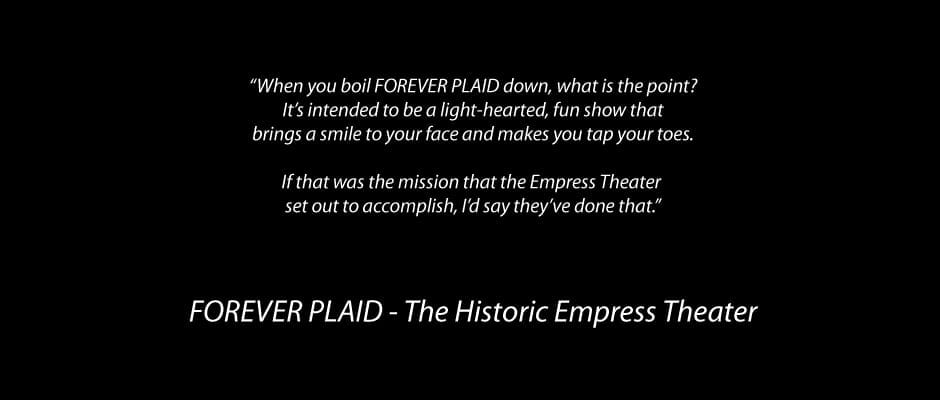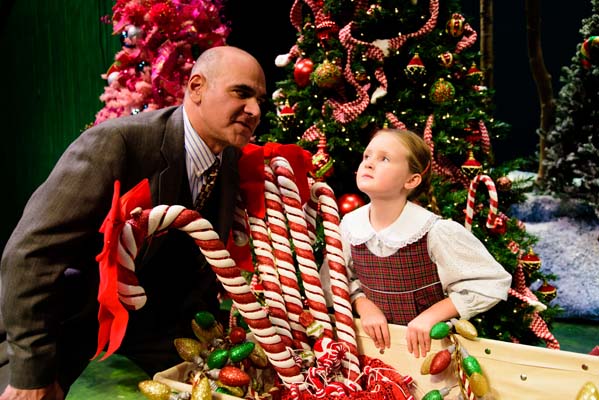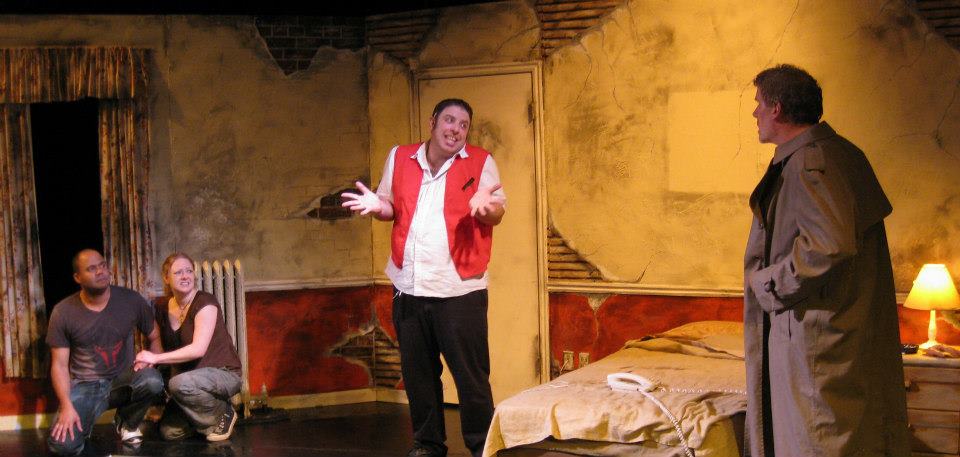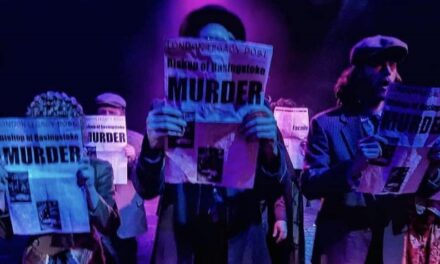MAGNA —I grew up in Payson, Utah—a decidedly small town. I hold many fond memories of nights spent with my family at the Payson Huish movie theater. I know we all see our childhoods through rose-colored glasses, but I tend to recall that there was a real feeling of community in that theater; an almost familial closeness. It seemed we all knew one another. Making it even more special for me, a good friend of the family owned the theater. My big brothers’ friends worked the concession stand. You were almost always seated next to a neighbor or schoolmate. It seemed a simpler, warmer time. Those feelings came rushing back to me as I entered the Empress Theater in Magna to enjoy their performance of Forever Plaid.
According the their website, The Empress was built back in 1916 with the explicit intention of providing burlesque shows for the Kennecott miners. Over the years, it housed silent movies as well as motion pictures. It closed down in the early 1930’s and sat vacant for over a half a century. A man local to the area named Leo Ware worked tirelessly to obtain the rights to the structure and began renovations to turn the dilapidated old theater into a functional playhouse. The Oquirrh Hills Performing Arts Alliance opened their first production in the space on November 4, 2006. That production was Forever Plaid. Now, five years and dozens of shows later, they’ve blown the dust off of four plaid dinner jackets and are once again presenting Forever Plaid.
Magna is quite a bit further out than I had visualized, and is a very small town. I felt a little like Lightning McQueen rolling into Radiator Springs—and I reside in Lehi! Needless to say, given the distance, I was relieved when we arrived 15 minutes before the “curtain” was set to raise. The exterior of the theater was quite festive and very eye-catching. Rows of full-sized, multi-colored light bulbs gleamed in the crisp fall air. We entered the building to the buzz of an anxious crowd. There was quite a long line of theater-goers waiting to obtain their tickets. Initially, I took this as a sign that the show would be very well-attended. However, I quickly realized that the staff could have used a bit of organizational help. Each transaction seemed to take an inordinate amount of time. They were very polite and helpful, but moving things along didn’t seem at the top of their do to list.
The theater has a very odd construction, in that the “stage” is set 3 steps down from street level. Facing the front of the stage are only two small rows of chairs. On the left and right sides of the stage, stadium seating goes up to the ceiling; nearly 20 rows high. Also, those stadium seats spread from the front of the stage to the back, making half of the seats behind the area most ideal for setting scenes. This creates some very difficult blocking scenarios, which were, for the most part, extremely well-handled by director Nancy Jensen.
As we sat awaiting the start of the show, we were surrounded by locals who were chattering with anticipation, recounting favorite shows they’ve seen at the Empress, going over their favorite Forever Plaid songs, and inquiring about one another’s families. Despite the sociability of those attending, there was no lead in music playing, which gave me a very stark, flat feeling.
I would venture a guess that Forever Plaid has been playing almost continuously throughout the state of Utah since the rights first became available for local productions in the mid ‘90s, so chances are you’ve seen it (or have been seen in it). If you haven’t, here’s a brief synopsis: It’s the story of a ’50s-style vocal quartet who were killed in a car accident on the way to their first big gig. They’re allowed to “come back” just long enough to perform their one big show, and we’re the lucky audience which plays witness to this trans-dimensional event. It’s a light-hearted, upbeat, fun show filled with catchy music, tight harmonies and funny gags.
And then, the show began. With note one, I was disappointed with the sound of the microphones and the mix of the voices. Music is the entire thrust of the show, and being about a vocal quartet, the blend and mix of the voices are critical. The unconventional layout of the space itself means that for much of the show one, two, or all four of the performers are on the far side of the stage, facing that section of the audience, which means that those on the “dark side” have to rely on the microphones and sound design. Needless to say, it left much to be desired.
The quartet is made up of four characters: Jinx, Frankie, Sparky, and Smudge played by Curtis Fred Nash, Matt Adams, Eric Barney and Joey Calkins, respectively. Three of the voices (Nash, Adams and Barney) were quite strong and sounded very natural together. Early in the evening I found myself straining to hear the bass lines and silently cursing the sound designer for not boosting Calkins’ microphone. However, as the evening progressed I came to realize that there wasn’t much the mic could offer. Calkins was clearly no bass, and seemed thoroughly lost in both music and blocking through much of the show. I realize that the character of Smudge is intended to be a bit clumsy and awkward, but many of the choices made by Calkins (if they were consciously made) didn’t play well and led me to feel uncomfortable watching him. Through numbers like “The Ed Sullivan Show – Lady of Spain,” it almost seemed as though we were inconveniencing him by wanting to hear his lines. They were secondary to his rushing off stage for the next prop. During his transcendent solo, “Rags to Riches,” he is finally allowed to sing in his natural register and we find that he has a decent voice. It’s a shame the time wasn’t spent on coaxing out this potentially fantastic character.
The choreographer of the show was not credited in the program, so I’ll assume that the dance moves were provided by director Nancy Jensen. During many of the early numbers, the choreography was exceptionally inventive and enjoyable to watch. The dances truly encompassed the entire space and rotated through the disjointed theater in such a way that it made us all feel a more active part in the performance, particularly in numbers like “Undecided” and “Crazy ‘Bout Ya Baby.”
In regards to the character development and believability, I was quite disappointed. Given the subject matter, it’s obvious that there aren’t a lot of heavy moments of sincere realization. However, there are quick vignettes throughout the show that can serve to offer real connections for the audience and I felt that in nearly every case, those moments were rushed through and passed over to get to the next song. I felt that Adams was particularly guilty of this transgression, specifically in his final monologue. He had a real chance in that instance to put aside the glossy, polished veneer and show us an actual person reaching out to lift his friends up. It was very rushed with no emotional connection whatsoever. His voice was classic and easily believable for the time period. Aside from those rushed moments, it was no stretch to imagine him as the front man of The Plaids.
Curtis Fred Nash as Jinx was perhaps the most solid character of the night. His voice is clear and very enjoyable. His presence is pleasant and unassuming. While he was also suffering from an underdeveloped character, I felt that his was the most real connection. I would have loved to see more trepidation and shyness from Jinx right up to that pivotal moment in his solo, “Cry,” where he gains his confidence, then a strong transition through the rest of the show. That aside, I was quite pleased with his performance.
Sparky, played by Eric Barney, brought a real sense of childlike enthusiasm to the stage. At times he was way over the top, but for the most part he helped up the energy for the entire quartet. He was very committed to his character and also had a clear, strong voice. He had a bit at the piano to bring the audience back from intermission that was my favorite part of the evening.
There were a number of songs that allowed the audience to get more involved, which they were more than willing to do. The Calypso section of the show was handled very well and was very fun to watch.
I would be remiss to not mention the great band, lead by pianist Tim Frost. They were front and center on the stage with much of the action happening all around them. I don’t think they missed a note, and I’m frustrated that neither the bassist nor the percussionist’s name appear in the program so I can give them their due. They were excellent!
I feel very confident in assuming that the first half of the show was rehearsed at least twice as much as the second half. What started off very strong seemed to reduce to a fizzle after the “Ed Sullivan Show.” My personal favorite song in the show, “Scotland the Brave” was so poorly done that it nearly made me weep, and not out of pride for my Scottish heritage. The harmonies were off, there was no dynamic variance, and it was performed at about double the speed intended.
When you boil Forever Plaid down, what is the point? It’s intended to be a light-hearted, fun show that brings a smile to your face and makes you tap your toes. If that was the mission that the Empress Theater set out to accomplish, I’d say they’ve done that. This is not a life-altering performance that you’ll someday tell your grandchildren about. But if you’d like an enjoyable evening, in a setting reminiscent of nostalgic childhood, get in line and buy a ticket.






